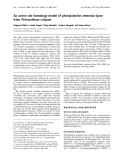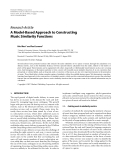
Similarity based models
-
The design of b-glycosidases with planed substrate specificity for biotechnological application has received little attention. This is mostly a consequence of the lack of data on the molecular basis of the b-glycosidase specificity, namely data on the energy of the noncovalent interactions in the enzymetransition state complex. In an attempt to fill this gap, sitedirected mutagenesis and enzyme steady-state kinetic experiments with different substrates were conducted, using as model a digestive b-glycosidase (glycoside hydrolase family 1) from Spodoptera frugiperda (Lepidoptera) (Sfbgly50).
 10p
10p  system191
system191
 01-06-2013
01-06-2013
 41
41
 4
4
 Download
Download
-
The plant enzyme phenylalanine ammonia-lyase (PAL, EC 4.3.1.5) shows homology to histidine ammonia-lyase (HAL) whose structure has been solved by X-ray crystallography. Based on amino-acid sequence alignment of the two enzymes, mutagenesis was performed on amino-acid residues that were identical or similar to the active site residues in HAL to gain insight into the importance of this residues in PAL for substrate binding or catalysis. We mutated the following amino-acid residues: S203, R354, Y110, Y351, N260, Q348, F400, Q488 and L138....
 11p
11p  system191
system191
 01-06-2013
01-06-2013
 65
65
 4
4
 Download
Download
-
In the postgenomic era it is essential that protein sequences are annotated correctly in order to help in the assignment of their putative functions. Over 1300 proteins in current pro-tein sequence databases are predicted to contain a PAS domainbaseduponaminoacid sequence alignments.Oneof theproblemswith the current annotationof thePASdomain is that this domain exhibits limited similarity at the amino acid sequence level.
 11p
11p  dell39
dell39
 03-04-2013
03-04-2013
 37
37
 5
5
 Download
Download
-
Tuyển tập báo cáo các nghiên cứu khoa học quốc tế ngành hóa học dành cho các bạn yêu hóa học tham khảo đề tài: Research Article A Model-Based Approach to Constructing Music Similarity Functions
 10p
10p  dauphong20
dauphong20
 10-03-2012
10-03-2012
 34
34
 5
5
 Download
Download
CHỦ ĐỀ BẠN MUỐN TÌM

















